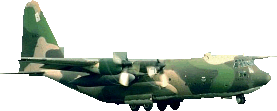The Lockheed C130 Hercules, or "Herc"
for short, was multi-purpose propeller driven aircraft used as a transport,
tanker, gunship, drone controller, airborne battlefield command and control
center, weather reconnaissance and electronic reconnaissance platform; as well
as search, rescue and recovery aircraft.
In the hands of the "Trash
Haulers," as the crew of the Tactical Air Command transports styled
themselves, the C130 proved to be the most valuable airlift instrument in the
Southeast Asia conflict. They were so valuable, in fact, that Gen. William
Momyer, 7th Air Force Commander, refused for a time to let them land at Khe Sanh
when the airstrip was under fire from NVA troops surrounding the base. The C130
was critical in resupplying American and allied troops in this area, and when
the Hercules could not land, it delivered its payload by means of a parachute
drop.
On 17 June 1966, Lt. Cmdr. Ralph B. Cobbs, pilot; Lt. JG Donald E.
Siegwarth, co-pilot; Lt. JG Edward L. Romig,
navigator; ADJ2 Curtis
D. Collette, flight mechanic/jet engines; YN2 Jack I. Dempsey, radio
operator; ADR2 Stanley J. Freng, flight mechanic/reciprocating engines; Lt. JG
Clement O. Stevenson, Jr., crewman; and AN M. J. Savoy, crewman; comprised the
crew of a C130E aircraft conducting an operational airlift mission. The mission
originated at Moffett Naval Air Station, California; proceeded to Kadena
Airbase, Okinawa, Japan; then to Cam Ranh Bay Airbase, South Vietnam. On the
return flight, they departed Cam Ranh Bay Airbase at 0215 hours with its crew of
eight and 6 passengers all members of the US Air Force. They were: 1st Lt.
Claiborne P. McCall, Capt. Connie M. Gravitte, SSgt. Oley N. Adams, SSgt. Robert
A. Cairns, SSgt. Gene K. Hess and AFC Larry E. Washburn.
Roughly 20 minutes after takeoff, the
USS Fortify, a US Navy gunboat, witnessed an explosion at approximately 1000
feet above the water with a subsequent explosion upon impacting the water.
Debris and fuel remaining on the surface of the water after the crash burned for
approximately 30 minutes. The location of the crash was 43 miles northeast of
Nha Trang, 16 miles south-southeast of Tuy Hoa, and 3 miles east of Lang Thuong,
Phu Yen Province, South Vietnam.
The USS Fortify was on the scene
within minutes and immediately initiated rescue efforts, to include coordinating
both surface and air search activities. The search operation was successful in
recovering the remains of Claiborne P. McCall and Clement O. Stevenson, Jr.;
however, they were unable to locate any trace of the rest of the crew and
passengers. At the time the extensive search effort was terminated on 21 June
1966, the remaining twelve men were listed Killed in Action/Body Not Recovered.
Because this incident occurred far out
to sea and in relatively deep water, the search and rescue (SAR) personnel
believed no remains could be recovered by enemy forces. The fate of the
remaining crew and passengers aboard the Hercules is not in doubt, and it
appears there's little to no chance of recovering their remains. For other
Americans who remain unaccounted for in Southeast Asia, their fate could be
quite different.
Since the end of the Vietnam War well
over 21,000 reports of American prisoners, missing and otherwise unaccounted for
have been received by our government. Many of these reports document LIVE
American Prisoners of War remaining captive throughout Southeast Asia TODAY.
American servicemen in Vietnam were
called upon to operate in many dangerous circumstances both on and off duty, and
they were prepared to be wounded, killed or captured. It probably never occurred
to them that they could be abandoned by the country they so proudly served.

Incidental Information



